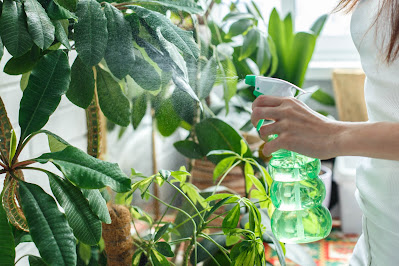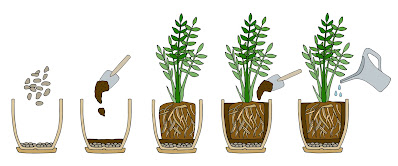What does paradise look like? We may never know, but one thing we can agree on is that it certainly does not have skyscrapers, fancy cars and shopping malls. In fact, our psyche picturizes paradise as a place that has all the magical, mystical and spectacular elements of Nature. One wonders what would it take for human beings to create something that comes close to what we shall call ‘A Paradise’.
The permaculture farm:
The moment you visit a fully functional, active permaculture farm, you immediately know that you have entered a place of abundance. Before even learning anything in detail about the place, you already feel the harmony, unity and balance in the system. You instantly connect with the natural energies being circulated within this place with a profound sense of belonging.
The first thing you notice is the permaculture farm site is much much greener than the surrounding locality, even in the hot and dry summers, like an oasis in the middle of a desert.
You also notice that the farm is densely planted. The greening is due to the sheer quantity of perennial herbs, shrubs, climbers and trees. It looks like an orderly forest, or a Nature Park.
This density is coupled with a great diversity. There is a wide range of productive plant varieties, support species, pioneer species as well as wild species growing together, having a positive impact on each other.
A permaculture farm is a vibrant ecosystem that supports local biodiversity. There is plenty of buzz around with birds, butterflies, bees and many other creatures. Most of the visiting and resident creatures engage in beneficial activities, having positive interactions with the flora and fauna of your farm.
In a permaculture farm, soil is protected, preserved and nurtured with a good amount of organic matter. Most importantly, rather than bringing soil from outside, the soil is naturally created within the farm system. Instead of exposing the naked, plowed, dead soil to direct sunlight on open fields, the soil is well shaded by canopy, heavily mulched and kept alive in its most active form.
In a permaculture farm, water available in all forms is captured, harvested, conserved, stored, spread and irrigated within the farming system by using various sustainable methods. There is an internal water cycle that is responsible for all the greenery and vice versa.
You let go of the obsession of bringing the whole land into one flat level by unnecessary and haphazard use of machinery. Instead, you use the existing topography to your advantage, whether its slopes, valleys, plateaus or flatlands.
You let go of the obsession of growing a single crop on long stretches of open fields, instead you aim for well synchronized multi-cropping. You discard the conventional monoculture practices and you adopt various innovative polyculture models, where you can also grow multiple main crops and staple food.
You let go of the mainstream, commercial/ industrial agricultural practices. The successful permaculture farmer thinks more like a gardener rather than agriculturist. An upscaled garden is way more productive than a downscaled agriculture field.
There are no synthetic fertilizers, no chemical pesticides, no harmful fungicides, no herbicides, no deep ploughing of land with tractors, no heavy tilling. You practice various sustainable methods of organic farming, natural farming, ecological farming, regenerative farming, and ethical landscaping.
There is an active kitchen garden where you grow all kinds of vegetables and herbs. The perennial vegetables, the fruiting veggies, leafies, climbers, the seasonal varieties and a lot more. In fact, the permaculture kitchen garden is one of the most productive systems on earth when it comes to yield per square meter.
Another key feature of any permaculture farm is the presence of a food forest. An ever evolving, self sustainable tree growing system that appears like a wild forest but the majority of plant species are edible. Here you mostly get all kinds of fruits, spices, and underground crops like roots and tubers.
long with plants, the farmyard animals like cattle, goats, chicken, ducks etc, have an important role to play in the permaculture systems. In Nature, every animal ‘gardens’ if they are allowed to perform their natural roles like earth loosening, weeding, feeding on insects, digging, scratching freely without us putting any pressure on ‘production’.
Just like diversity of species, there is diversity of habitats. Along with gardens, maincrops and food forest, there are water bodies, ponds, streams, rockery, pastures, and most importantly a patch of absolutely wild forest growing naturally in your property.
In an active permaculture farm, you get along with local caretakers, farm labours, workers and supervisors, and they get along with you and your farm. In fact, the locals actively participate and contribute positively to the overall development of the farm.
The main objective of a permaculture farm is that the owner’s family should achieve most of its ‘food self reliance’ through this farm. You get your family's annual supply of grains, pulses, fruits, vegetables, herbs and spices from your own permaculture farm. You scale it up to share the increasing surplus with extended family, relatives, friends, visitors, locals and community.
The above information just scratches the surface when it comes to what permaculture is all about. Permaculture is in fact a multidisciplinary, vast topic and you learn as you practice on the field.
If you wish to design, or re-design your farm according according to permaculture principles. Or if you want our professional advise regarding overall planning and management of your farm activities you can reach out to me.
Visit our website to know more about Nature First.
Like Nature First's facebook page
Comment down below and share this blog to people who may find this useful.
Follow me on this blog to read more content like this
-Harshad Ainapure (M.Sc. Botany, SET), Director at Nature First Horticultures.
Call/WhatsApp: 9326166338/ 8169716382
harshad.naturefirst@gmail.com






















